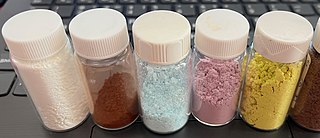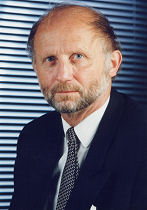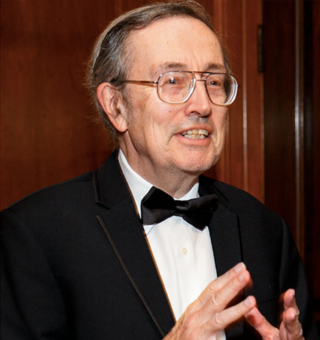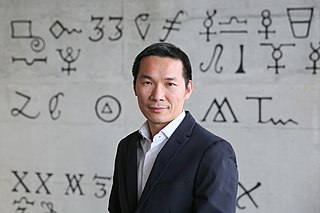Related Research Articles

In chemistry, a polyoxometalate is a polyatomic ion, usually an anion, that consists of three or more transition metal oxyanions linked together by shared oxygen atoms to form closed 3-dimensional frameworks. The metal atoms are usually group 6 or less commonly group 5 and group 7 transition metals in their high oxidation states. Polyoxometalates are often colorless, orange or red diamagnetic anions. Two broad families are recognized, isopolymetalates, composed of only one kind of metal and oxide, and heteropolymetalates, composed of one or more metals, oxide, and eventually a main group oxyanion. Many exceptions to these general statements exist.
Artificial photosynthesis is a chemical process that biomimics the natural process of photosynthesis. The term artificial photosynthesis is used loosely, referring to any scheme for capturing and then storing energy from sunlight by producing a fuel, specifically a solar fuel. An advantage of artificial photosynthesis would be that the solar energy could converted and stored. By contrast, using photovoltaic cells, sunlight is converted into electricity and then converted again into chemical energy for storage, with some necessary losses of energy associated with the second conversion. The byproducts of these reactions are environmentally friendly. Artificially photosynthesized fuel would be a carbon-neutral source of energy, but it has never been demonstrated in any practical sense. The economics of artificial photosynthesis are noncompetitive.

Water splitting is the chemical reaction in which water is broken down into oxygen and hydrogen:

Silicotungstic acid or tungstosilicic acid is a heteropoly acid with the chemical formula H4[SiW12O40]. It forms hydrates H4[SiW12O40]·nH2O. In freshly prepared samples, n is approximately 29, but after prolonged desiccation, n = 6. It is a white solid although impure samples appear yellow. It is used as a catalyst in the chemical industry.

In chemistry, the heteropolymetalates are a subset of the polyoxometalates, which consist of three or more transition metal oxyanions linked together by shared oxygen atoms to form a closed 3-dimensional molecular framework. In contrast to isopolymetalates, which contain only one kind of metal atom, the heteropolymetalates contain differing main group oxyanions. The metal atoms are usually group 6 or less commonly group 5 transition metals in their highest oxidation states. They are usually colorless to orange, diamagnetic anions. For most heteropolymetalates the W, Mo, or V, is complemented by main group oxyanions phosphate and silicate. Many exceptions to these general statements exist, and the class of compounds includes hundreds of examples.

Achim Müller was a German chemist. He was Professor Emeritus at the Faculty of Chemistry, University of Bielefeld.

Robert Howard Crabtree is a British-American chemist. He is serving as Conkey P. Whitehead Professor Emeritus of Chemistry at Yale University in the United States. He is a naturalized citizen of the United States. Crabtree is particularly known for his work on "Crabtree's catalyst" for hydrogenations, and his textbook on organometallic chemistry.

Daniel George Nocera is an American chemist, currently the Patterson Rockwood Professor of Energy in the Department of Chemistry and Chemical Biology at Harvard University. He is a member of the National Academy of Sciences and the American Academy of Arts and Sciences. In 2006 he was described as a "major force in the field of inorganic photochemistry and photophysics". Time magazine included him in its 2009 list of the 100 most influential people.
Nathan S. Lewis is the George L. Argyros Professor of Chemistry at the California Institute of Technology (Caltech). He specializes in functionalization of silicon and other semiconductor surfaces, chemical sensing using chemiresistive sensor arrays, and alternative energy and artificial photosynthesis.
A solar fuel is a synthetic chemical fuel produced from solar energy. Solar fuels can be produced through photochemical, photobiological, and electrochemical reactions.

Ulrich "Uli" Kortz is a German chemist and professor, working in the area of synthetic polyoxometalate chemistry.
The OxFA process is a process to produce formic acid from biomass by catalytic oxidation using molecular oxygen or air. Polyoxometalates of the Keggin-type are used as catalysts.

Photogeochemistry merges photochemistry and geochemistry into the study of light-induced chemical reactions that occur or may occur among natural components of Earth's surface. The first comprehensive review on the subject was published in 2017 by the chemist and soil scientist Timothy A Doane, but the term photogeochemistry appeared a few years earlier as a keyword in studies that described the role of light-induced mineral transformations in shaping the biogeochemistry of Earth; this indeed describes the core of photogeochemical study, although other facets may be admitted into the definition.
Karen Ila Goldberg is an American chemist, currently the Vagelos Professor of Energy Research at University of Pennsylvania. Goldberg is most known for her work in inorganic and organometallic chemistry. Her most recent research focuses on catalysis, particularly on developing catalysts for oxidation, as well as the synthesis and activation of molecular oxygen. In 2018, Goldberg was elected to the National Academy of Sciences.

Water oxidation catalysis (WOC) is the acceleration (catalysis) of the conversion of water into oxygen and protons:
Jenny Yue-fon Yang is an American chemist. She is a Professor of chemistry at the University of California, Irvine where she leads a research group focused on inorganic chemistry, catalysis, and solar fuels.
The Bionic Leaf is a biomimetic system that gathers solar energy via photovoltaic cells that can be stored or used in a number of different functions. Bionic leaves can be composed of both synthetic and organic materials (bacteria), or solely made of synthetic materials. The Bionic Leaf has the potential to be implemented in communities, such as urbanized areas to provide clean air as well as providing needed clean energy.
Steven L. Suib is an American inorganic chemist, academic and researcher. He is a Board of Trustees Distinguished Professor of Chemistry at University of Connecticut. He is a director of the Institute of Materials Science and of the Center for Advanced Microscopy and Materials Analysis.

Xile Hu is a Swiss chemist specialized in catalysis. He is a professor in chemistry at EPFL and leads the Laboratory of Inorganic Synthesis and Catalysis at the School of Basic Sciences.
Stafford W. Sheehan is an American scientist and entrepreneur, a co-founder and chief technology officer of Air Company. He developed a heterogeneous catalysis process to convert carbon dioxide into ethanol that his company has used to produce vodka and other consumer products as well as jet fuel.
References
- Weinstock, I. A.; Barbuzzi, E.M.G.; Wemple, M.W.; Cowan, J. J.; Reiner, R. S.; Sonnen, D. M.; Heintz, R. A.; Bond, J. S.; Hill, C. L. “Equilibrating metal oxide cluster ensembles for oxidation reactions using oxygen in water” Nature, 2001, 414, 191-195.
- Hill, C. L. Polyoxometalates: Reactivity” Comprehensive Coordination Chemistry II: From Biology to Nanotechnology, Elsevier: Amsterdam; Volume 4; Wedd, A. G.; Ed., 2004; pp. 679–759.
- Geletii, Y. V.; Botar, B.; Kögerler, P.; Hillesheim, D. A.; Musaev, D. G.; Hill, C. L. “An all-inorganic, stable and highly active tetra-ruthenium homogeneous catalyst for water oxidation” Angew. Chem. Int. Ed. 2008, 47, 3896-3899.